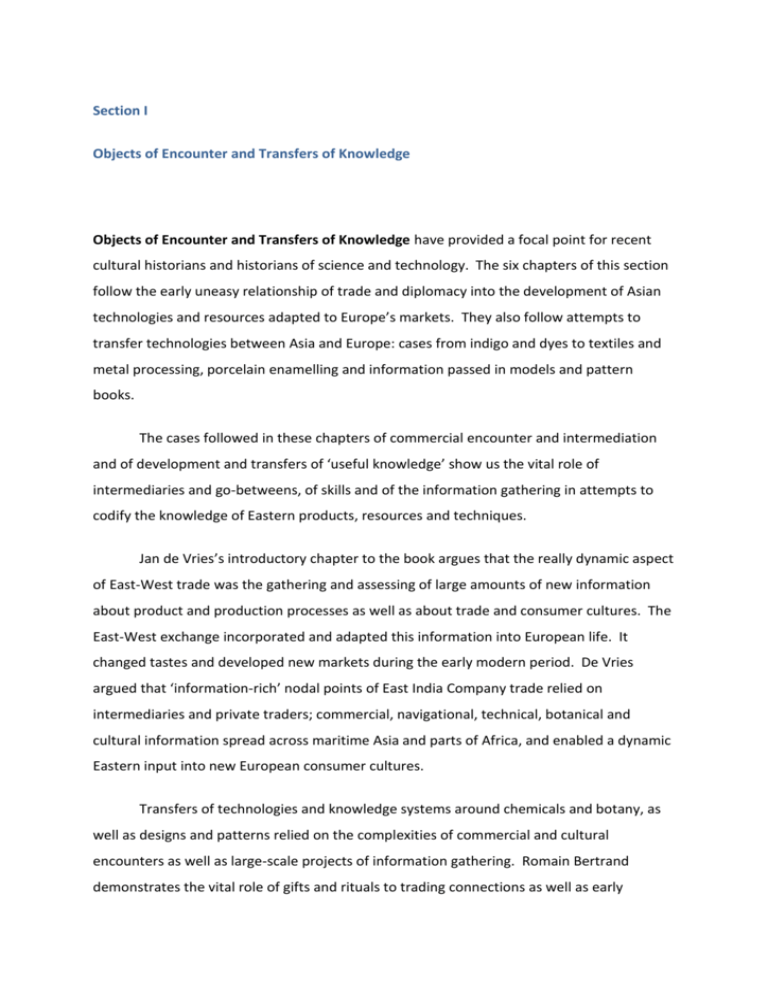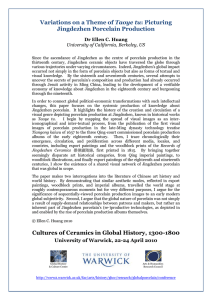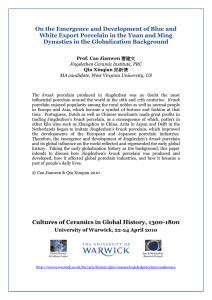Section I Objects of Encounter and Transfers of Knowledge Objects
advertisement

Section I Objects of Encounter and Transfers of Knowledge Objects of Encounter and Transfers of Knowledge have provided a focal point for recent cultural historians and historians of science and technology. The six chapters of this section follow the early uneasy relationship of trade and diplomacy into the development of Asian technologies and resources adapted to Europe’s markets. They also follow attempts to transfer technologies between Asia and Europe: cases from indigo and dyes to textiles and metal processing, porcelain enamelling and information passed in models and pattern books. The cases followed in these chapters of commercial encounter and intermediation and of development and transfers of ‘useful knowledge’ show us the vital role of intermediaries and go-betweens, of skills and of the information gathering in attempts to codify the knowledge of Eastern products, resources and techniques. Jan de Vries’s introductory chapter to the book argues that the really dynamic aspect of East-West trade was the gathering and assessing of large amounts of new information about product and production processes as well as about trade and consumer cultures. The East-West exchange incorporated and adapted this information into European life. It changed tastes and developed new markets during the early modern period. De Vries argued that ‘information-rich’ nodal points of East India Company trade relied on intermediaries and private traders; commercial, navigational, technical, botanical and cultural information spread across maritime Asia and parts of Africa, and enabled a dynamic Eastern input into new European consumer cultures. Transfers of technologies and knowledge systems around chemicals and botany, as well as designs and patterns relied on the complexities of commercial and cultural encounters as well as large-scale projects of information gathering. Romain Bertrand demonstrates the vital role of gifts and rituals to trading connections as well as early merchant intermediaries. Portuguese intermediaries mediated early European encounters in Bantam; the Dutch dealt through Chinese and Gujarati merchants in Java. The moral norms of trade agreements moving between noble and mercantile codes of behaviour were as difficult to achieve as common standards over different weights and measures. These basic problems of encounter and intermediation underpinned the early problems of transmitting textile dyes and printing techniques. An active indigo trade developed between Mughal India and Europe in the first half of the Eighteenth Century. Ghulam Nadri connects this trade to a great diffusion of knowledge of indigo making, quality testing and dyeing techniques as the Dutch, English and Levant Companies competed. Transfers of technologies relied on key skilled workers. Olivier Raveux follows the case of calico printing as techniques spread from India to Persia, and from there to Marseilles. Armenian merchants in Marseilles played a vital role in accessing these skills and in adapting Asian merchandise to European tastes. They also played a part in introducing ‘Turkey Red’ madder dyeing techniques. Their history is part of the still little-studied migration of tastes, products, men and techniques across the Eurasian land mass. One Indian textile key to incentives to transform the European cotton industry was fine muslins. Manufactured in Bengal, especially Dhaka, they were highly prized during the Seventeenth and Eighteenth Centuries. All the European East India Companies sought information on the location, skills and production processes of the best producers in an attempt to access their products for trade to Europe. This information gathering gained momentum during the last quarter of the Eighteenth Century as European dress fashions to the looser fitting styles incorporating fine muslin fabrics. During the 1790s John Taylor, the Chief Resident at Dhaka embarked on a major project to identify the weaving communities, document their production processes and problems, their payment and poverty. This was a major investigation yielding a large report, and some fifty years later transformed into a book to coincide with the Great Exhibition. The trade in luxury goods such as the Dhaka muslins and the accumulation of information on the skills and craftsmanship that went into their making also raise important questions of chronology over Asian manufacture and the industrialization of the British cotton industry. Chinese techniques not only made their way to the West through documents such as pattern books, but also absorbed Western crafts such as enamelling. Dagmar Schaefer shows the place of pattern books in the design culture of the Qing imperial court. Details of designs were sent to the imperial kilns in Jingdezhen and to other craft centres, and pattern books circulated among craftsmen. Private producers, however, also used pattern books to market products and skills through the Asian market. Chinese designs were conveyed in European pattern books, and one early nineteenth-century Lancashire traveller and collector, Thomas Bellot collected an important Chinese embroidery pattern book among the artefacts, painting guides and manuscripts he brought from China, bringing this into circulation among Western manufacturers. The Chinese from the later Seventeenth Century adopted European techniques of painted enamel, experimenting in developing a Chinese version of the craft in Jingdezhen and Guangzhou. The imperial kilns in Jingdezhen produced porcelain-bodied painted enamel and famille rose porcelain; this coincided with a new popularity of enamel painting in Europe. Xu Xiaodong shows us a technique initially brought from Europe, then reconfigured in Chinese porcelain and export-ware goods gave rise to a new spread of the technique and design in Europe. Europeans interacting in South East Asia, India, Persia and China encountered great difficulties in finding the goods they wanted, identifying the resources and skills necessary to make them, and codifying the information they sought to transmit back to Europe. That transmission through the textiles and porcelain that came from the East to transform European consumer cultures was both complex and multi-directional.











